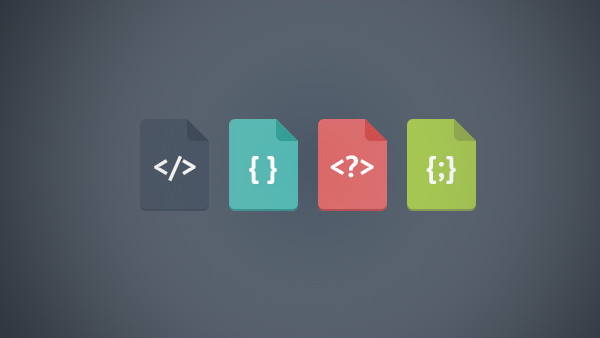@if
@if 指令是一个 SassScript,它可以根据条件来处理样式块,如果条件为 true 返回一个样式块,反之 false 返回另一个样式块。在 Sass 中除了 @if 之,还可以配合 @else if 和 @else 一起使用。
假设要控制一个元素隐藏或显示,我们就可以定义一个混合宏,通过 @if...@else... 来判断传进参数的值来控制 display 的值。如下所示:
//SCSS@mixin blockOrHidden($boolean:true) { @if $boolean { @debug "$boolean is #{$boolean}";
display: block;
} @else { @debug "$boolean is #{$boolean}";
display: none;
}
}
.block { @include blockOrHidden;
}
.hidden{ @include blockOrHidden(false);
}编译出来的CSS:
.block { display: block;
}.hidden { display: none;
}@for循环
在制作网格系统的时候,大家应该对 .col1~.col12 这样的印象较深。在 CSS 中你需要一个一个去书写,但在 Sass 中,可以使用 @for 循环来完成。在 Sass 的 @for 循环中有两种方式:
@for $i from <start> through <end> @for $i from <start> to <end>
$i 表示变量
start 表示起始值
end 表示结束值
这两个的区别是关键字 through 表示包括 end 这个数,而 to 则不包括 end 这个数。
如下代码,先来个使用 through 关键字的例子:
@for $i from 1 through 3 {
.item-#{$i} { width: 2em * $i; }}编译出来的 CSS:
.item-1 { width: 2em;
}.item-2 { width: 4em;
}.item-3 { width: 6em;
}再来个 to 关键字的例子:
@for $i from 1 to 3 {
.item-#{$i} { width: 2em * $i; }}编译出来的 CSS:
.item-1 { width: 2em;
}.item-2 { width: 4em;
}@for应用在网格系统生成各个格子 class 的代码:
//SCSS $grid-prefix: span !default;
$grid-width: 60px !default;
$grid-gutter: 20px !default;
%grid {
float: left;
margin-left: $grid-gutter / 2;
margin-right: $grid-gutter / 2;
}
@for $i from 1 through 12 {
.#{$grid-prefix}#{$i}{
width: $grid-width * $i + $grid-gutter * ($i - 1);
@extend %grid;
}
}编译出来的 CSS:
.span1, .span2, .span3, .span4, .span5, .span6, .span7, .span8,
.span9, .span10, .span11, .span12 { float: left; margin-left: 10px; margin-right: 10px;
}.span1 { width: 60px;
}.span2 { width: 140px;
}.span3 { width: 220px;
}.span4 { width: 300px;
}.span5 { width: 380px;
}.span6 { width: 460px;
}.span7 { width: 540px;
}.span8 { width: 620px;
}.span9 { width: 700px;
}.span10 { width: 780px;
}.span11 { width: 860px;
}.span12 { width: 940px;
}@while循环
@while 指令也需要 SassScript 表达式(像其他指令一样),并且会生成不同的样式块,直到表达式值为 false 时停止循环。这个和 @for 指令很相似,只要 @while 后面的条件为 true 就会执行。
这里有一个 @while 指令的简单用例:
//SCSS$types: 4;
$type-width: 20px;
@while $types > 0 {
.while-#{$types} {
width: $type-width + $types;
}
$types: $types - 1;
}编译出来的 CSS
.while-4 { width: 24px;
}.while-3 { width: 23px;
}.while-2 { width: 22px;
}.while-1 { width: 21px;
}@each循环
@each 循环就是去遍历一个列表,然后从列表中取出对应的值。
@each 循环指令的形式:
@each $var in <list>
在下面的例子中你可以看到, var 会在列表中做遍历,并且遍历出与 $var 对应的样式块。
var 会在列表中做遍历,并且遍历出与 $var 对应的样式块。
这有一个 @each 指令的简单示例:
$list: adam john wynn mason kuroir;//$list 就是一个列表
@mixin author-images {
@each $author in $list {
.photo-#{$author} {
background: url("/images/avatars/#{$author}.png") no-repeat;
}
}
}
.author-bio {
@include author-images;
}编译出 CSS:
.author-bio .photo-adam { background: url("/images/avatars/adam.png") no-repeat; }.author-bio .photo-john { background: url("/images/avatars/john.png") no-repeat; }.author-bio .photo-wynn { background: url("/images/avatars/wynn.png") no-repeat; }.author-bio .photo-mason { background: url("/images/avatars/mason.png") no-repeat; }.author-bio .photo-kuroir { background: url("/images/avatars/kuroir.png") no-repeat; }Sass的函数简介:
在 Sass 中除了可以定义变量,具有 @extend、%placeholder 和 mixins 等特性之外,还自备了一系列的函数功能。其主要包括:
字符串函数
数字函数
列表函数
颜色函数
Introspection 函数
三元函数等
当然除了自备的函数功能之外,我们还可以根据自己的需求定义函数功能,常常称之为自定义函数。
字符串函数-unquote()函数
字符串函数顾名思意是用来处理字符串的函数。Sass 的字符串函数主要包括两个函数:
unquote($string):删除字符串中的引号;
quote($string):给字符串添加引号。
1、unquote()函数:
unquote() 函数主要是用来删除一个字符串中的引号,如果这个字符串没有带有引号,将返回原始的字符串。简单的使用终端来测试这个函数的运行结果:
//SCSS.test1 {
content: unquote('Hello Sass!') ;
}
.test2 {
content: unquote("'Hello Sass!");
}
.test3 {
content: unquote("I'm Web Designer");
}
.test4 {
content: unquote("'Hello Sass!'");
}
.test5 {
content: unquote('"Hello Sass!"');
}
.test6 {
content: unquote(Hello Sass);
}编译后的 css 代码:
//CSS.test1 {
content: Hello Sass!; }
.test2 {
content: 'Hello Sass!; }
.test3 {
content: I'm Web Designer; }
.test4 {
content: 'Hello Sass!'; }
.test5 {
content: "Hello Sass!"; }
.test6 {
content: Hello Sass; }注意:从测试的效果中可以看出,unquote( ) 函数只能删除字符串最前和最后的引号(双引号或单引号),而无法删除字符串中间的引号。如果字符没有带引号,返回的将是字符串本身。
quote() 函数刚好与 unquote() 函数功能相反,主要用来给字符串添加引号。如果字符串,自身带有引号会统一换成双引号 ""。如:
//SCSS.test1 {
content: quote('Hello Sass!');
}
.test2 {
content: quote("Hello Sass!");
}
.test3 {
content: quote(ImWebDesigner);
}
.test4 {
content: quote(' ');
}编译出来的 css 代码:
//CSS.test1 {
content: "Hello Sass!";
}
.test2 {
content: "Hello Sass!";
}
.test3 {
content: "ImWebDesigner";
}
.test4 {
content: "";
}使用 quote() 函数只能给字符串增加双引号,而且字符串中间有单引号或者空格时,需要用单引号或双引号括起,否则编译的时候将会报错。
.test1 { content: quote(Hello Sass);
}这样使用,编译器马上会报错:
error style.scss (Line 13: $string: ("Hello""Sass") is not a string for `quote')解决方案就是去掉空格,或者加上引号:
.test1 {content: quote(HelloSass);
}.test1 { content: quote("Hello Sass");
}同时 quote() 碰到特殊符号,比如: !、?、> 等,除中折号 - 和 下划线_ 都需要使用双引号括起,否则编译器在进行编译的时候同样会报错:
error style.scss (Line 13: Invalid CSS after "...quote(HelloSass": expected ")", was "!);") error style.scss (Line 16: Invalid CSS after "...t: quote(Hello": expected ")", was “?);")
字符串函数-To-upper-case()、To-lower-case()
1、To-upper-case()
To-upper-case() 函数将字符串小写字母转换成大写字母。如:
//SCSS.test {
text: to-upper-case(aaaaa);
text: to-upper-case(aA-aAAA-aaa);
}编译出来的 css 代码:
//CSS
.test {
text: AAAAA;
text: AA-AAAA-AAA;
}2、To-lower-case()
To-lower-case() 函数 与 To-upper-case() 刚好相反,将字符串转换成小写字母:
//SCSS.test {
text: to-lower-case(AAAAA);
text: to-lower-case(aA-aAAA-aaa);
}编译出来的 css 代码:
//CSS
.test {
text: aaaaa;
text: aa-aaaa-aaa;
}数字函数-percentage()
percentage()函数主要是将一个不带单位的数字转换成百分比形式:
.footer{ width : percentage(.2)
}编译后的 css 代码:
.footer{ width : 20%}数字函数-round()函数
round() 函数可以将一个数四舍五入为一个最接近的整数:
.footer { width:round(12.3px)
}编译后的 css 代码:
.footer { width: 12px;
}数字函数-ceil()函数
ceil() 函数将一个数转换成最接近于自己的整数,会将一个大于自身的任何小数转换成大于本身 1 的整数。也就是只做入,不做舍的计算:
.footer { width:ceil(12.3px);
}编译后的 css 代码:
.footer { width: 13px;
}数字函数-floor()函数
floor() 函数刚好与 ceil() 函数功能相反,其主要将一个数去除其小数部分,并且不做任何的进位。也就是只做舍,不做入的计算:
.footer { width:floor(12.3px);
}编译后的 css 代码:
.footer { width: 12px;
}数字函数-abs()函数
abs( ) 函数会返回一个数的绝对值。
.footer { width:abs(-12.3px);
}编译后的 css 代码:
.footer { width: 12.3px;
}数字函数-min()函数、max()函数
min()函数
min() 函数功能主要是在多个数之中找到最小的一个,这个函数可以设置任意多个参数:
>> min(1,2,1%,3,300%)1%>> min(1px,2,3px)1px>> min(1em,2em,6em)1em
不过在 min() 函数中同时出现两种不同类型的单位,将会报错误信息:
>> min(1px,1em)SyntaxError: Incompatible units: 'em' and 'px'. max()函数
max() 函数和 min() 函数一样,不同的是,max() 函数用来获取一系列数中的最大那个值:
>> max(1,5)5>> max(1px,5px)5px
同样的,如果在 max() 函数中有不同单位,将会报错:
>> max(1,3px,5%,6)SyntaxError: Incompatible units: '%' and ‘px'.
数字函数-random()函数
random() 函数是用来获取一个随机数:
>> random()0.03886>> random()0.66527>> random()0.8125>> random()0.26839>> random()0.85063
作者:我待前端如初恋
链接:https://www.jianshu.com/p/279d0d030373

 随时随地看视频
随时随地看视频




